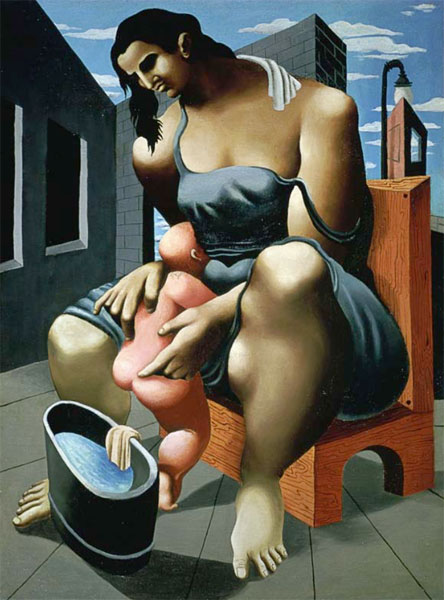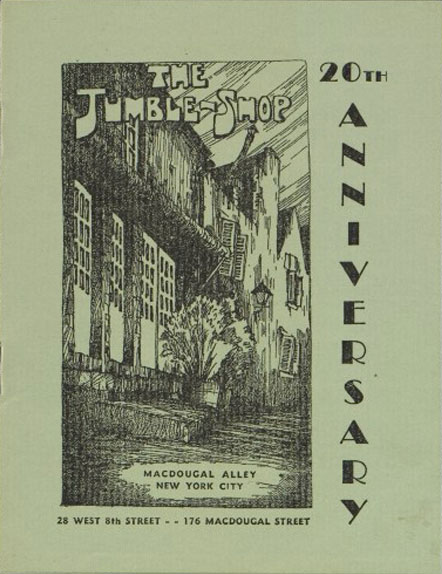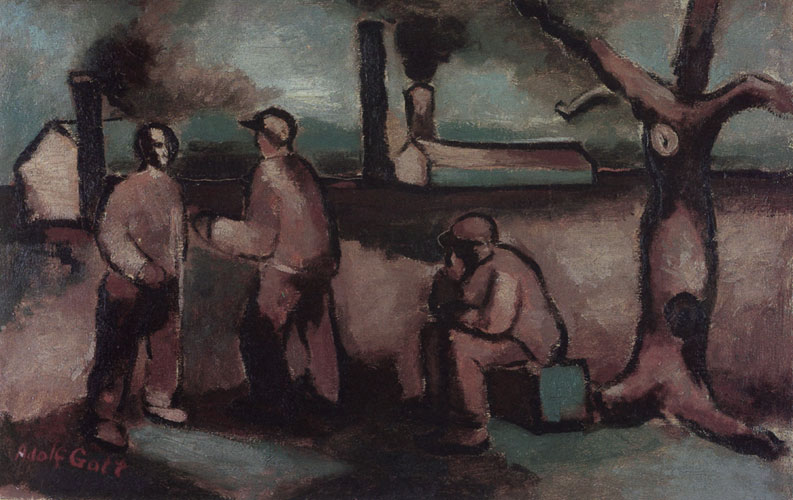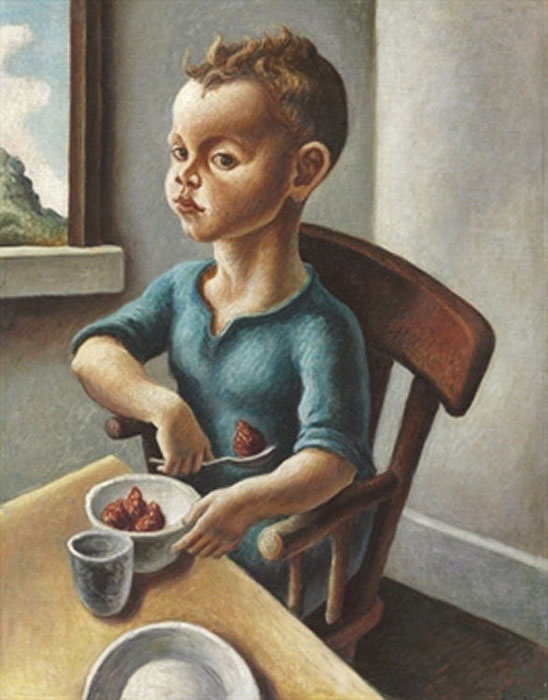Abstract Expressionism 1930
by Gary Comenas (2009, Updated 2016)
The Great Depression worsens - more than 5 million Americans are out of work. (DK89)
January 18 - March 2, 1930: "Painting in Paris" exhibition at The Museum of Modern Art.
Arshile Gorky attended the exhibition which consisted of fifteen Picassos, eleven Matisses in addition to work by Giorgio de Chirico, Fernand Léger and Joan Miró. According to artist Peter Busa, Gorky loved Picasso's Seated Woman (1927). Busa recalls "He (Gorky) would stand in front of it for an hour at a time." (BA184) Gorky's advice to Busa about Busa's own work was "You've paid your rent. Now do something else with them. You got to fuck 'em up, Busa. You must transform your drawings! You've got to fuck 'em up." (BA214)
Gorky painted two of his own versions of the Seated Woman - a gouache on cardboard and later a larger oil painting. (BA184)
Diane Waldman [1981]:
Significantly, Gorky used Picasso's forms, often quite literally, yet he rejected Picasso's characteristic brutality. Picasso's Seated Woman is part human, part predatory animal... In Gorky's Painting, however, there is no violence, no brutality... Gorky's sensibility is exquisite and lyrical. Despite his debt to Picasso, this painting is imbued with the grace and idealism and poetry which mark his lifelong oeuvre. (BA184)
1930: Philip Guston paints Mother and Child.
Guston later recalled in reference to the painting, "I painted this when I was only seventeen, in a closet with Dutch boy house paints." (MM16) He would exhibit the painting in 1933 at the 14th Annual Exhibition at the Los Angeles Museum.

Philip Guston, Mother and Child (1930) (oil on canvas, 40 x 30 in.) Philadelphia Museum of Art
Philip Guston (1978):
As a boy I would hid in the closet when the older brothers and sisters came with their families to to Mama's apartment for the Sunday afternoon dinner visit. I felt safe. Hearing their talk about illnesses, marriages, and the problems of making a living, I felt my remoteness in the closet with the single light bulb. I read and drew in this private box. Some Sundays I even painted. I had given my dear Mama passionate instructions to lie. 'Where is Philip?' I could hear them ask. 'Oh, he is away - with friends,' she would manage, in a trembling voice. It was so good to be away. I was happy in my sanctuary. (MM24)
c. 1930: Milton Avery moves to 72nd Street.
Milton Avery and his wife, Sally, moved from Lincoln Square to 72nd Street. Adolph Gottlieb and Mark Rothko were frequent visitors. (AG16)
c. 1930: Arshile Gorky visits his girlfriend's father in an insane asylum.
Arshile Gorky's lover, Ruth French (real name: Sirun Mussikian), who he had met in 1929, had not been particularly forthcoming with information about her father. Gorky wondered whether he had ever come across her father during Gorky's childhood in Van. Sirun eventually told him that her father was still alive but that she didn't want to see him again. He was in a mental asylum in Watertown. But she never told Gorky the full story - that her father suffered from severe paranoia and had shot her when she was twelve years old. Sirun would later say that her father had told her that "life was so awful, so terrible, he didn't want me to have any part in it." (BA181)
Gorky found out where her father was hospitalised and went to visit him. He came back saying that he had been impressed by her father's intelligence and that he deserved a better life. He had previously been a bacteriologist at Chicago University. Gorky took Sirun to visit him. Later she recalled that the visit "was pretty sad. I had been about twelve years old and now I was twenty. I really didn't want to see him and I only went up because Gorky wanted me to. My father was just as cold and indifferent as he always had been. He was very disappointed with me because I wasn't in college." (BA180)
Early 1930s: Willem de Kooning, John Graham, Stuart Davis and Arshile Gorky hang out at the Jumble Shop and Romany Marie's.
From De Kooning: An American Master by Mark Stevens and Annalyn Swan:
... there was a sprinkling of younger artists who also found their way into this progressive circle [Gorky, de Kooning, Graham and Davis], notably the sculptor David Smith... On many nights in the early 1930s, Gorky, Graham and Davis could be found, surrounded by attentive clusters of friends and disciples, at their two Village haunts, both left over from the bohemian days of Greenwich Village at the turn of the century. Davis's was the Jumble Shop, a coffeehouse and restaurant on the corner of Eighth Street and MacDougal Alley near Washington Square Park, the heart of Greenwich Village. Twenty years earlier, the Jumble Shop had been the gathering place of Thomas Wolfe and other writers... Just down Eighth Street from the new Whitney Museum, which opened in 1931 at 10 West Eighth Street, it mainly attracted the American realist painters, along with Davis [whom the Whitney had also recognized) and his little band of modernists.

Front cover of the booklet produced for the Jumble Shop's 20th anniversary, 1942
Frances Russell (one of the proprietors of the Jumble Shop), February 20, 1942:
Twenty one years ago today The Jumble Shop served its first dinner to the public in the original little restaurant across the street at "Twenty-One"... Slowly and steadily, not without many grown pains it reached a point where larger quarters were needed and January first 1926, a New Year's Eve party celebrated the Jumble Shop's move to its new and present quarters...
From the beginning we were fortunate in the persons who were attract to the Jumble Shop... A page from the Guest Book which we should have kept but did not would have contaained even in the early days such distinguished names as Daniel Chester Frenc, whose Seated Lincoln is the focal point of the Lincoln Memorial in Washington, Jules Bok, immortalized in teh Bok Singing Tower, Dudly Digges, Theodore Dreiser, Martha Graham, William Glackens, Rudulph Evan, who wears the ribbon of the Legion of Honor of France, Deems Taylor, Hunt Deidrich, Margaret Wycherley, Harold Dietz, Tom Powers, Heinrich Von Loon, George Copeland, Henri Deering... ("The Jumble Shop: 20th anniversary, 1942," Archives of American Art)
Another hangout was Romany Marie's:
From De Kooning: An American Master
by Mark Stevens and Annalyn Swan:
Even more than the Jumble Shop, which Davis favoured, it was Romany Marie's - and its patrons John Graham and Arshile Gorky - that attracted de Kooning and the other young modernists... According to David Smith, 'Romany Marie's was our hangout. In the early 1930s we drank coffee and hung around New York like expatriates.' Then located on a narrow Village side street called Minetta Lane, Romany Marie's was tiny, dark, and intimate... A previous version of the restaurant, at 133 Washington Place, had been memorialised by the Ash Can painter John Sloan in a painting called Romany Marie's Garden...
In the dark, cozy interiors of Romany Marie's and the Jumble Shop... de Kooning's ideas about modern art were further sharpened. In the circle de Kooning frequented Paris was sacred and the 'Bible' was Cahiers d'Art... Often, talk would turn to the unconscious and Graham's interest in automatic writing. (DK105-108)
In addition to being a "coffeeshop and restaurant," the Jumble Shop also exhibited the work of artists.
Joseph Solman:
I worked with my wife in a book store on Eighth Street, the International Book and Art shop. The man who ran it is dead now, Joseph Kling. He was a crotchety character, but he knew his literature, he knew his poetry. He taught us E.E. Cummings and T.S. Eliot and many of the good writers. And he also kept a lot of prints in his shop and etchings. In fact, he was the one before I ever worked in his shop when I showed in an outdoor show, I think, in '31 or '32 - that was the only time I showed in a Washington Square show with those little gouaches I told you about - because I used to buy prints from this fellow, I asked him to keep my bundles in the back of his shop so I didn't have to drag them back to Jamaica [Long Island]. And when the week was over, whatever it was, when the period was over, the Washington Square exhibit, he gruffly told me to unpack them and show him the pictures and told me to lay aside a few [in the roughest manner possible], and then he asked me how much I wanted for each of them. I think at that time I asked three, four, or five dollars for each of them. And he bought a bunch and he showed them and he sold them.
... when I was in that outdoor show, they had monthly shows at the Jumble Shop. You submitted. And somebody told me about it. Besides selling those few gouaches to Kling, I submitted some around that period to the Jumble Shop and I was accepted. And they hung three or four of my gouaches in a large group show there. The jury was Guy Pene du Bon, Reginald Marsh, and a guy who used to do cartoons for the Daily News. He's a very good cartoonist. He had a whole page… low-down characters. I think his name was Hill. This goes way back. And the woman reported to me that they were enthusiastic about gouaches, which certainly made me feel good, and I think one of them was bought by this very cartoonist, Hill, if I remember his name right. So these little things, you know, were meaningful to a young painter. (JM)
March 12 - April 2, 1930: "Weber, Klee, Lehmbruck, Maillol" exhibition at The Museum of Modern Art.
Ninety-eight works by Max Weber were included in the exhibition.
April 11 - April 27, 1930: Arshile Gorky exhibits at the Museum of Modern Art.
Three still-lifes by Arshile Gorky were included by in the museum's exhibition "46 Painters and Sculptors under 35 Years of Age."One of the still-lifes was loaned by art dealer J.P. Neumann - Gorky's first art dealer. According to Gorky biographer Hayden Herrera, it was "very likely the American Expressionist Max Weber introduced Gorky to Neumann." (HH216) Neumann kept Gorky's work for several months during 1930 but failed to sell any. When Neumann was away in Philadelphia Gorky took back his paintings from the gallery, complaining to the secretary that Neumann had never done anything for him. (HH216)
The catalogue for the MoMA exhibition identified Gorky as "Archele Gorki" who was born in 1903 Nizhni Novrogod and had studied there and at Tiflis and for three months in 1920 with Kandinsky. None of the information was true. Alfred Barr, the museum's director, later recalled that "Gorky's listing was somewhat fanciful. I recall that about then or shortly afterwards he let it be known that he was a Georgian prince. Anyway the misinformation was his fantasy, not ours." (HH215/6)
May 1930: Adolph Gottlieb has his first one-man show - at the Dudensing Gallery in New York.
Adolph Gottlieb was the first prize winner (along with Konrad Cramer) of a nationwide competition in 1929 sponsored by the Dudensing Gallery. As an award the gallery gave them both one-man shows in different parts of the gallery.
Adolph Gottlieb:
I was teaching at a summer camp and I received a notice asking me to submit some paintings for a competition. One of the jurors was a man who had apparently liked my work. He had selected it for the show and written about it in some review. I think he used to write for the New Yorker... Anyway, I left the camp for a few days, got quite a few paintings together and submitted them. I was a winner in the competition. it was a national competition, an annual thing conducted by the Dudensing Galleries. That was the old Dudensing... I don't know what they had done previously but this time it was a joint award. The other winner was a fellow named Konrad Cramer from Woodstock. So we both got this award and we were both given one-man shows simultaneously in different parts of the gallery... If you had a one-man show in those days it meant that you were sort of a recognized artist... Nobody could say I wasn't an artist now. (AS)
Among the works that Gottlieb exhibited were South Ferry Waiting Room (c.1929), Brooklyn Bridge (c. 1930) and The Wasteland (c. 1930) (AG15)

The Wasteland (1930), Adolph Gottlieb, 22 x 34" (AGP)
From "Adolph Gottlieb: His Life and Art" by Mary Davis MacNaughton in Adolph Gottlieb: A Retrospective
:
The style of these pictures... is more expressionistic... As he had in the twenties, Gottlieb continued to use a muted palette, as seen in Brooklyn Bridge. Although this picture is related to the tradition of Sloan's genre scenes of New York, such as The City from Greenwich Village (1922), its inward view is opposed to Sloan's dynamic vista... In the tradition of Joseph Stella and Hart Crane, whose works he surely knew, Gottlieb adopted the Brooklyn Bridge as an emblem of New York. But instead of a gateway to a vital city, his bridge is a barrier before a ghostly metropolis...
In The Wasteland Gottlieb simplifies forms, defining them with thick, dark contour lines. Like Avery, he also contrasts painted and incised lines and brushes up to the edges of forms, surrounding them with shadows that do not create a sense of depth as much as reverberation. This haloing technique, which Gottlieb first employed in his expressionist works of the early thirties, reappears later in abstract form in the auras around discs in the Bursts. But The Wasteland is a transitional work in Gottlieb's search for his own style. While he attempted a greater distillation of form, he still maintained a dark palette and heavily painted surface, reflecting the lingering influence of Sloan. (AG16)
May 27, 1930: The Chrysler Building opens.
At the time of its completion it was the tallest building in the world due to a 125 foot high spire added to the roof during its construction in 1929. It would be surpassed by the Empire State Building when it opened the following year.
Late May/Early June 1930: Willem de Kooning goes to Woodstock.
De Kooning and his live-in lover, Virginia "Nini" Diaz, rented a house - the so-called Smith House - in Woodstock for the summer season with Tully Filmus and his wife Joan and Anton Refregier. Refregier was a Russian emigre who worked at the Eastman Brothers with de Kooning. One of his duties was to go to de Kooning's boarding house and wake him up for work. Tully also worked for the Eastman Brothers in 1929. According to Nini, "... Bart van der Schelling [who rented a cottage nearby] was the cook and I took care of the house... We had the front room. And we had a ball." (DK69)
June 1930: Jackson Pollock's brothers visit Jackson in L.A.
Jackson Pollock's brothers, Charles and Frank returned to Los Angeles for the summer. In New York Frank had been studying literature at Columbia University and worked part-time in the university's law library. Charles had been attending the Art Students League. Charles encouraged Jackson to leave Manual Arts and come to New York. Jackson took him up on the offer and enrolled in the Art Students League in September 1930. (JP46-7) During the summer in L.A. Jackson and Charles went to see Josè Clemente Orozco's Prometheus fresco in the recently completed Frary Hall of Pomona College in Claremont, California. (PP317)
Autumn 1930: Willem de Kooning and Nini move house.
Their new apartment was at 348 E. 55th Street in the same area as Tully Filmus. Nini's mother also moved in. They remained there until the latter part of 1932. (DK88)
Autumn 1930: Willem De Kooning's girlfriend has an abortion.
It was the first of three abortions that Nini had during her relationship with de Kooning. (DK88)
Autumn 1930: "Picasso Drawings and Gouaches" at the John Becker Gallery.
One of the visitors to the exhibition was Arshile Gorky. (BA190)
Autumn 1930: Franz Kline has an operation.
During his senior year at high school Kline injured his knee during football practice which required an operation. While he was recuperating he thought about going to art school to specialize in cartooning. He contributed a cartoon calendar to his high school's 1930-31 yearbook. (FK175)
1930: Philip Guston enrolls at Otis Art Institute in Los Angeles.
While at Otis (on a scholarship), Philip Guston befriended Reuben Kadish and also met his future wife, Musa McKim. Guston's daughter, also named Musa, would later marry Kadish's son. During the 1930s Kadish and Guston would work on several murals together including a proscenium arch over a stage (with Sande Pollock) in 1934, a mural for the University museum in Morelia Mexico during 1934/35, The Inquisition in 1934/35 (with Jules Langsner), and the City of Hope mural in Duarte California painted in 1935/36 (and restored in June 1998).
First year students at Otis were required to draw from casts rather than life models. Guston and Kadish, however, avoided this rule by sneaking into the life drawing classes during their first year. They also set up their own small studio, without permission, in an unused space behind the school's locker room. Through Kadish, Guston met Los Angeles artist Lorser Feitelson and became a frequent visitor to his studio. Feitelson introduced both students to the Arensberg collection of modern European art. Guston often spoke about de Chirico's The Poet and the Muse in the collection and would later say that "Feitelson showed me Piero della Francesca for the first time... He opened up the Renaissance for me."(MM14-17)
In 1935, when Time magazine published an article on the Morelia fresco by Guston and Kadish, the article referred to both artists as "parlor pinks" who were "influenced by a Los Angeles esthete known as Lorser Feitelson" who "was anxiously trying to burst in the news... as the prophet of a new art movement called Post-Surrealism or New Classicism."
Lorser Feitelson:
The New Classicism is the antithesis of the esthetically of the esthetically irrelevant psychological illustration of the popular Expressionist-Surrealists and should in no way be identified with their dadaistic denial of the universality of the esthetic. The graphic objectification of the conscious and subconscious psychic meanderings in itself does not create art... (TW)
1930: Miró's first solo exhibition in America at the Valentine Gallery.
Arshile Gorky attended the exhibition. (BA190)
September 1930: Jackson Pollock moves to New York and enrolls at the Art Students League.
Jackson Pollock followed his brothers Charles and Frank to New York. Accompanying him was Manuel Tolegian, previously his classmate at Manual Arts.
Manuel Tolegian:
... Pollock and I left for New York together... we didn't live together, we shared studios together for some time, and then we began studying with Thomas Benton first... and then Benton left to paint murals in '33 in the state of Indiana for the World's Fair and when he did John Sloan took his classes at the Art Students League. So we studied with him for awhile, and then John Stuart Curry came there and George Grosz, for about four years we studied together, Pollock and the rest of us. (ST)
After taking free sculpture classes at Greenwich House, a neighbourhood association on Barrow Street, Jackson enrolled at the Art Students League and joined his brother Charles in Thomas Hart Benton's class, "Life Composition, Painting and Drawing". The class met on weekday evenings from 7 pm to 10 pm in Studio 9. (JP48-49/PP317)

T.P. Three Years Old (1929) by Thomas Hart Benton (25 x 20 in.)
(Signed "Benton," lower right - signed again on reverse with inscription, "To T.P., 3 yrs old - from - Dad.")
Thomas Hart Benton would remain Jackson's mentor for the next eight years of his life. (JP49) During his first year of study, Jackson and his brother Charles lived in an apartment (at 46 Union Square) that had previously belonged to Benton. (JP53) The painter Harry Holtzman, who was also at the school when Pollock was there thought that Pollock "tailed after Benton like a puppy dog. Whatever Benton did, he wanted to do it too." (JP56)
Jackson Pollock:
I spent two years at the Art Students League. Tom Benton was teaching there then, and he did a lot for me. He gave me the only formal instruction I ever had, he introduced me to Renaissance art, and he got me a job in the League cafeteria. I'm damn grateful to Tom. He drove his kind of realism at me so hard I bounced right into non-objective painting. (US)
Thomas Hart Benton:
It is absurd to stick a Cézanne water-color in the face of an average intelligent American citizen and expect him to find much in it. The same goes for a Braque or a Kadinsky pattern. Most Americans on seeing them will say, "If that's art, to hell with it." (quoted in NY Times obituary, Jan. 21, 1975)
A few months before Pollock arrived in New York, Benton had received his first mural commission. Titled America Today the work consisted of nine panels for the New School for Social Research, later purchased (in 1984) by the Equitable Life Assurance Society. (JP50) The Mexican painter, José Clemente Orozco was also commissioned to do a mural for the New School's dining room. (JP50)
Pollock was around during the last three months that Benton worked on the mural and would sometimes act as a model for the painting. He also helped Benton to mix his paints, wash his brushes and sweep the floor. Pollock wrote to his father on February 3, 1933 that "Benton is beginning to be recognized as the fore most American painter today," adding "He has lifted art fro the stuffy studio into the world and happenings about him, which has a common meaning to the masses." (JP51)
Benton later recalled in his autobiography, An Artist in America (first published in 1937) that Jackson's artistic abilities "seemed to be of a most minimal order." (JP52) In a rough draft of a letter to Francis V. O'Connor in 1964, Benton noted that Jackson Pollock "got things out of proportion but found their essential rhythms." (JP53) A fellow student at the League, Yvonne Pene du Bois, later recalled that Jackson "couldn't draw, and he knew he couldn't draw, and I think it made him miserable." (JP52) However, Pollock's paintings from the period show a greater skill than either Benton or de Bois gave him credit for.